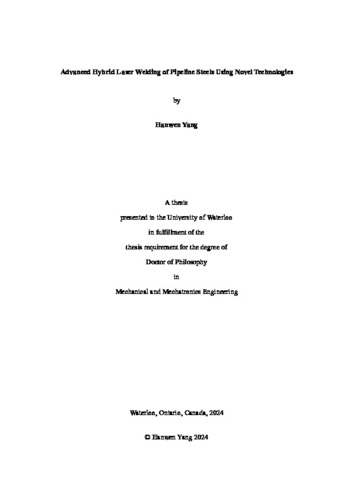| dc.contributor.author | Yang, Hanwen | |
| dc.date.accessioned | 2024-04-23 20:27:39 (GMT) | |
| dc.date.available | 2024-04-23 20:27:39 (GMT) | |
| dc.date.issued | 2024-04-23 | |
| dc.date.submitted | 2024-04-19 | |
| dc.identifier.uri | http://hdl.handle.net/10012/20478 | |
| dc.description.abstract | Laser beam welding using a high energy density source is a promising method for joining thick plates due to its deep penetration and high productivity, although there are drawbacks such as poor gap-bridging ability, and fast cooling which can lead to weld metal brittleness in more hardenable carbon steels. These limitations can be overcome by adding a filler wire into the weld pool. Meanwhile, novel technologies including beam wobbling and hot-wire feeding have shown the potential to improve the mechanical properties of laser welds. The aim of the present work is to pursue the development of a state-of-art hybrid laser welding process as a root pass for the welding of high strength low-alloy pipeline steels with improved weld quality, mechanical properties, and increased productivity.
The first part of the current research focused on the effect of hot-wire feeding ER70S-6 wire on the microstructure and mechanical properties of API X80 steel laser welds. A high wire feed rate along with preheating of the wire limited the formation of brittle microconstituents such as bainite and martensite in the weld metal, leading to an acicular-ferrite-dominated microstructure. The weld metal strength and toughness met the industrial requirement, although the hardness exceeded the maximum value allowed.
Further study was conducted utilizing a wobble laser during wire-fed laser welding process. Beam wobbling technique provided the potential to increase the gap-bridging ability. However, increased amount of bainite was found due to the dilution effect with more melted base material in the fusion zone, and this led to an increase in the hardness and strength of the weld metal.
Utilizing a hot-wire feed together with a wobble laser with a small spot size improved the fusion zone microstructure homogeneity and reduced the weld metal hardness. The preheating of the substrates reduced the cooling rate and resulted in the formation of more ferrite. Heat-affected zone hardness was also reduced with the preheating. A larger root gap was found to limit the dilution of alloying elements from the filler material, providing sufficient nucleation sites for the formation of acicular ferrite.
The influence of wire chemistry was then investigated with the optimized welding parameters. Introducing an ER70S-2 wire with a lower carbon equivalent into the weld pool led to a coarser weld metal microstructure, and resulted in a lower hardness and a sufficient toughness which met the API standard. Considering the high productivity and satisfactory mechanical properties of the laser welds, the welding procedure proposed by this work indicates strong potential for utilizing laser welding for more applications in the pipeline industry. | en |
| dc.language.iso | en | en |
| dc.publisher | University of Waterloo | en |
| dc.subject | laser welding | en |
| dc.subject | pipeline steels | en |
| dc.subject | laser beam wobbling | en |
| dc.subject | hot-wire feeding | en |
| dc.title | Advanced hybrid laser welding of pipeline steels using novel technologies | en |
| dc.type | Doctoral Thesis | en |
| dc.pending | false | |
| uws-etd.degree.department | Mechanical and Mechatronics Engineering | en |
| uws-etd.degree.discipline | Mechanical Engineering | en |
| uws-etd.degree.grantor | University of Waterloo | en |
| uws-etd.degree | Doctor of Philosophy | en |
| uws-etd.embargo.terms | 0 | en |
| uws.contributor.advisor | Gerlich, Adrian | |
| uws.contributor.affiliation1 | Faculty of Engineering | en |
| uws.published.city | Waterloo | en |
| uws.published.country | Canada | en |
| uws.published.province | Ontario | en |
| uws.typeOfResource | Text | en |
| uws.peerReviewStatus | Unreviewed | en |
| uws.scholarLevel | Graduate | en |

